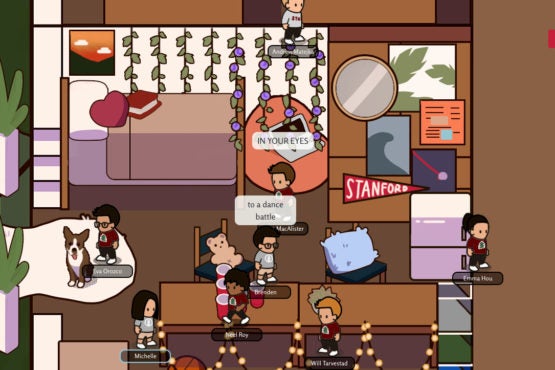A new virtual platform is helping the Stanford community recapture the campus experience. It’s called Club Cardinal, and it’s turned the university into an online, interactive space.
Go to the web site to view the video.
“We wanted to make a virtual Stanford campus where the entire community – students, faculty and staff – could reconnect and see each other again on one platform, and also see the campus,” said Michelle Qin, ’23.
Qin and fellow Stanford undergrads WenXin Dong, ’23; Allison Zhang, ’23; Sreya Halder, ’23; and Azhia Harris, ’20, are the creators of Club Cardinal. Together they designed and developed the platform to be a virtual reproduction of the Farm and to also serve as a space for the community to socialize and experience Stanford life while living, working and studying apart.
Created during spring quarter for a computer science competition, Club Cardinal recently opened up to the broader Stanford community. According to its creators, hundreds of Stanford students and other university affiliates have joined and are active on the platform.
“In our first three days of launch, there were over 1,550 Stanford students who logged into Club Cardinal from around the world,” Qin said.
Virtual campus life
Club Cardinal is a free desktop website, but it operates much like a video game. After registering with a stanford.edu email address, users create a personal profile and build an avatar by selecting and modifying features such as hair color and clothing. Users are also given their own dorm room.

Inside Club Cardinal, every user has their own dorm room, which they can furnish and decorate. (Image credit: Club Cardinal)
Users can then explore the virtual Stanford campus by navigating a map that features various campus locations, including Tresidder Union, Meyer Green, the Oval, the Dish and the Arrillaga Outdoor Education and Recreation Center. Within each location, users can see and interact with other avatars and join each location’s Zoom room for video chatting.
The “Event Schedule” button on the map page serves as a central calendar system that shows all of the events happening in each location’s Zoom room. Club Cardinal is already hosting virtual events for the Stanford community. Just this week, the Stanford Summer Engineering Academy held its first meeting on the Oval, which attracted dozens of participants.
Club Cardinal has a currency system that allows users to accumulate coins, which are deposited into a virtual bank account. Coins are earned through various tasks. Logging into the platform every day, for example, will net users five coins, and for every few minutes they are active, they will earn one coin.
Club Cardinal also has a virtual store where coins can be used to purchase such items as furniture and decorations for dorm rooms. Dong said that she and her teammates are working on making those spaces even more interactive.
“Users will soon be able to link their own Zoom meeting IDs to their personal dorm rooms,” she said. “So people can bring their friends over and they can have a more private chat.”
Club Cardinal’s creators are encouraging Stanford faculty to join. Several faculty members have visited the site, including professors. Once on the platform, faculty are distinguished from students through red name tags. Custom-made avatars are also available for faculty who request them.
“We wanted to recreate the experience of bumping into anyone on campus,” Qin said.
A winning innovation
Club Cardinal was created for the Stanford Women in Computer Science (WiCS) Innovation Challenge, a 10-week spring quarter competition for teams of students to create a project guided by an industry professional. With this year’s competition moved online due to the COVID-19 pandemic, Dong, Qin, Zhang, Harris and Halder brainstormed project ideas that could reconnect the Stanford community. After deciding to create a virtual and interactive Stanford campus, they spent the next several weeks coding and designing graphics.
Their innovation earned them first place in the competition, which came with a $500 cash prize that they’ve invested into further developing Club Cardinal. The project also received a COVID-19 Creative Community Response Grant from the Office of the Vice President for the Arts and was recently featured in Stanford mediaX’s Very Virtual Retreat.
Since opening to Stanford affiliates on Aug. 1, Club Cardinal has received rave reviews from users. Jackson Parell, one of the Class of 2022 presidents, said that he was blown away by the amount of care and attention to detail the students put into creating Club Cardinal.
“It’s stuff like this that is gonna keep the Stanford community strong,” he wrote in a review.
Club Cardinal has several upcoming events planned, including Q&As with student clubs, coffee chats with faculty and a summer reunion for the Class of 2023. Updates on events are available on the Club Cardinal Instagram account. Anyone interested in hosting an event on Club Cardinal can fill out this form.
To contact Club Cardinal’s developers, send an email to clubcardinal1@gmail.com.
